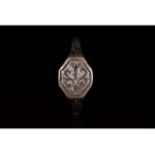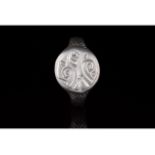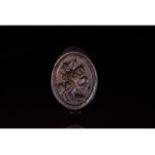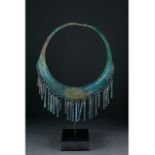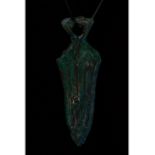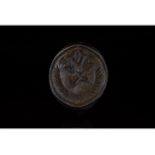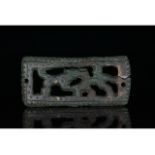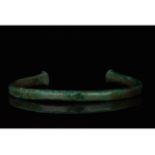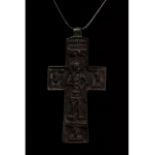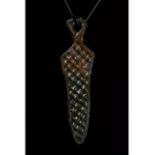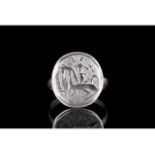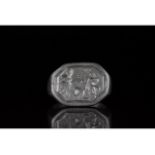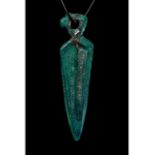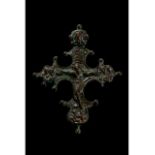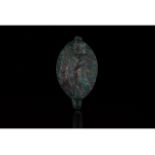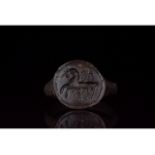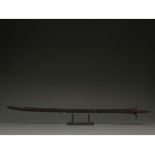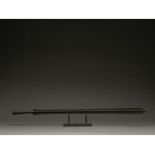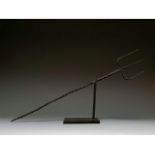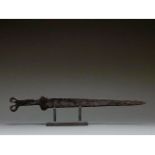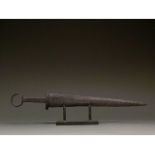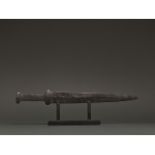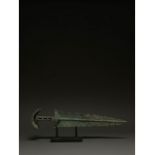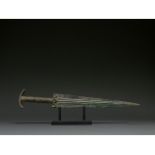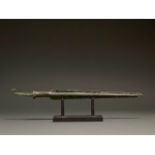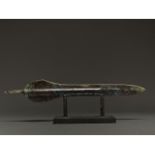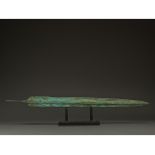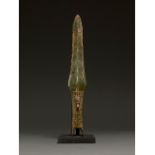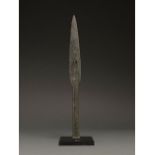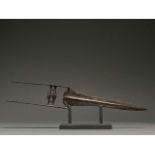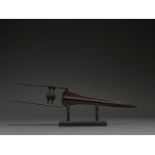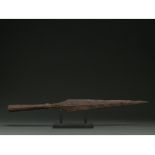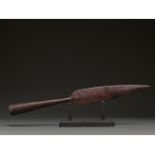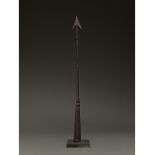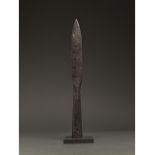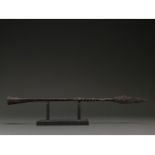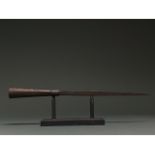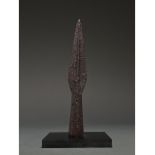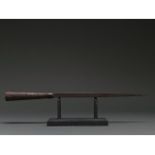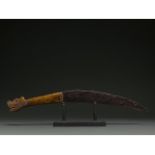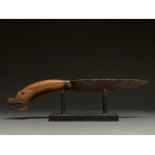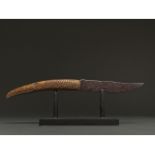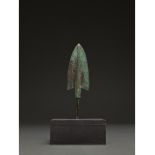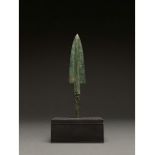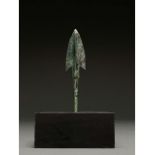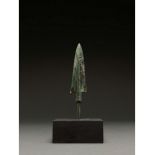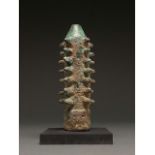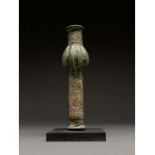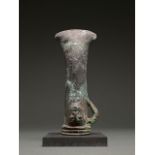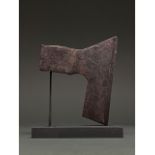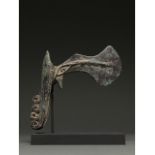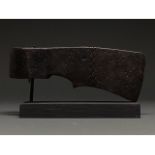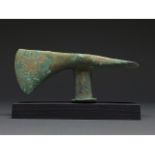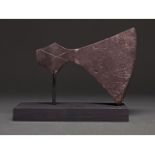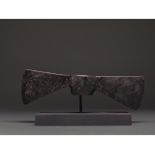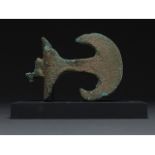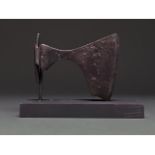Refine your search
Filtered by:
- Category,
- Item Type
- List
- Grid
A subscription to the Price Guide is required to view results for auctions ten days or older. Click here for more information
1200-1500 AD. Later Crusader period. Silver ring with circular hoop and flattened, octagonal bezel which bears incised decoration depicting vegeta...
1100-1300 AD, Medieval. Silver ring with circular hoop and flattened, round bezel featuring incised decoration including a stylised beast, possibl...
1100-1500 AD, Medieval. Bronze signet ring with circular hoop and flattened, oval-shaped bezel featuring an engraved horse and rider motif within ...
C. 900-1100 AD. Viking Period. This beautiful bronze torc features a wide, flat neck piece, from which dangle dozens of metallic tassels, and a de...
700-1100 AD. Viking Age. Bronze sword-shaped amulet with suspension loop at the top, and a stylised depiction of a leaf-shaped blade with several ...
1200-1600 AD. Medieval. Bronze ring with D-Shaped hoop, gently flaring shoulders and an oval bezel. The bezel bears incised decoration in the form...
100-300 AD. Roman. Rectangular bronze fitting with openwork depiction of a wolf pursuing a rabbit or hare; the scene is surrounded by a border of ...
ROMAN BRONZE ARMILLA BRACELET
C. 100-300 AD. Roman. A heavy bronze armilla bracelet with rectangular section and sub-elliptical, recurved terminals. Armillae were armband style...
1000-1500 AD. Medieval Crusaders period. Large bronze Latin cross with rounded suspension loop and moulded decoration showing St George, armed wit...
700-1100 AD. Viking Age. Bronze sword-shaped amulet with suspension loop at the top, and a stylised depiction of a leaf-shaped blade with interloc...
550-800 AD. Avar. Silver ring with round hoop and circular plate bezel with incised horse and rider motif within a circle. The Avars were warlike ...
1100-1300 AD. Medieval. Silver ring with circular hoop and flattened, hexagonal bezel featuring incised decoration depicting a hunter fighting a b...
ROMAN ARMILA BRONZE BRACELET
C. 100-300 AD. Roman. A bronze armilla bracelet with rectangular section and sub-elliptical, recurved terminals. Armillae were armband style brace...
700-1100 AD. Viking Age. Bronze sword-shaped amulet with suspension loop at the top, and a stylised depiction of a leaf-shaped blade with a fuller...
C. 2000-700 BC, Luristan culture. A Luristan cast bronze mace head with a pointed tip, cylindrical body featuring four neat rows of spikes running...
c. 323-31 BC. Greek Hellenistic period. A bronze ring with a round loop and flattened elliptical bevel bearing an incised figure of Hercules in th...
ROMAN BRONZE RING WITH HORSE
1-200 AD. Roman. Bronze ring with round hoop and flattened, hexagonal bezel bearing an incised galloping horse motif. The cavalry played a major r...
C. 600 AD. Migration Period. A long iron sword with a long, pointed, bevelled blade, a rectangular guard, and a long, rectangular tang for affixin...
c. 323-31 BC. Hellenistic. Huge iron spearhead with leaf-shaped blade, prominent midrib, flaring shoulder and circular socket. The Hellenistic per...
ROMAN IRON TRIDENT
100-300 AD. Roman. Iron trident with three long, widely-spaced prongs and twisted tang for insertion into a wooden haft. A trident is a three-pron...
600-400 BC. Scythian. Iron Acinaces-type sword with pointed, elongated triangular blade, B-shaped guard, rectangular handle and openwork winged po...
600-400 BC. Scythian. Iron Acinaces-type sword with pointed, elongated triangular blade, rectangular guard, tapering handle and ring pommel. The a...
600-400 BC. Scythian. Iron Acinaces-type sword with pointed, elongated triangular blade, narrow guard, rectangular handle and pommel. The acinaces...
1200-700 BC, Greek Archaic Period. This beautiful bronze sword has a tapering, bevelled blade with raised midrib, an integral handle with openwork...
1200-700 BC, Greek Archaic Period. This beautiful cast bronze sword has a tapering, bevelled blade with tripartite raised midrib with a double ful...
1200-700 BC, Greek Archaic Period. A beautiful cast bronze sword bronze sword with a leaf-shaped, lentoid sectioned blade,a tripartite raised midr...
1200-700 BC, Greek Archaic Period. This beautiful bronze spear has a tapering, bevelled blade with a prominent midrib, a neck with twisted decorat...
1200-700 BC, Greek Archaic Period. This beautiful bronze dagger has a leaf-shaped, bevelled blade with a prominent midrib, and a tang for insertio...
1200-700 BC, Greek Archaic Period. A This beautiful cast bronze sword with a leaf-shaped, lentoid sectioned blade, a tripartite raised midrib with...
c. 475 BC – 221 BC. Warring States Period. Bronze spearhead with leaf-shaped, lentoid-section blade and central midrib. The lower part of the sp...
800 – 600 BC. Greek Hoplite Period. Socketed Bronze spearhead comprising a substantial leaf-shaped, lentoid-section blade with a truncated raise...
C. 1526 - 1857 AD. Mughal Empire. An iron Katar dagger or knuckleduster comprising a two-part, bulging grip with guard and leaf-shaped blade with ...
C. 1600 – 1800 AD. Post-medieval. An iron Katar dagger or knuckleduster comprising a two-part, bulging grip with guard and leaf-shaped blade wit...
1400-1500 AD. Late medieval. Iron spearhead with elongated lozenge-shaped head, terminating in a narrow point, narrow cheek, flaring neck and circ...
C. 300-500 AD Roman. A large iron spearhead comprising a slender leaf-shaped, lentoid sectioned blade with a slightly raised midrib and a socket f...
C. 100-300 AD. Roman. An iron pilum spear head with a barbed, triangular blade, and a long, narrow neck, and a robust flaring socket. Pila were a ...
C. 300-500 AD Roman. An iron spearhead comprising a slender tapering blade and a long socket for increased control. Weapons of this type were used...
C. 1-300 AD. Roman. A large socketed iron pilum spear head with a leaf-shaped blade and twisted neck. Pila were a key part of Roman military equip...
900-1100 AD. Viking Age. Iron lancehead with pointed, pyramidal head, flaring neck and circular socket. The era known as the Viking age lasted for...
C. 300-500 AD Roman. An iron spearhead comprising a squat leaf-shaped, lentoid sectioned blade with a raised midrib and a socket for increased con...
900-1100 AD. Viking Age. Iron lancehead with pointed, pyramidal head, flaring neck and circular socket. The era known as the Viking age lasted for...
C. 900 AD. Viking age. Medieval Scandinavian, pointed knife; expertly cleaned and conserved with hand-carved, reconstructed bone handle depicting ...
C. 900 AD. Viking age. Medieval Scandinavian, pointed knife; expertly cleaned and conserved with hand-carved, reconstructed bone handle depicting ...
C. 900 AD. Viking age. Medieval Scandinavian, pointed knife; expertly cleaned and conserved with hand-carved, reconstructed bone handle depicting ...
ANCIENT BRONZE SPEAR ON STAND
1200-700 BC, Greek Archaic Period. Bronze Age. A bronze spearhead with a leaf-shaped, lentoid sectioned blade, a raised midrib and a short neck de...
ANCIENT BRONZE SPEAR ON STAND
1200-700 BC, Greek Archaic Period. Bronze Age. A bronze spearhead with a broad leaf-shaped, lentoid sectioned blade, a raised midrib and a short n...
ANCIENT BRONZE SPEAR ON STAND
1200-700 BC, Greek Archaic Period. Bronze Age. A bronze spearhead with a leaf-shaped, lentoid sectioned blade, a raised midrib and a short neck th...
ANCIENT BRONZE SPEAR ON STAND
1200-700 BC, Greek Archaic Period. Bronze Age. A bronze spearhead with a broad leaf-shaped, lentoid sectioned blade, a raised midrib and a short n...
ANCIENT BRONZE SPEAR ON STAND
1200-700 BC, Greek Archaic Period. Bronze Age. A bronze spearhead with a flaring leaf-shaped, lentoid sectioned blade, a raised midrib and a short...
C. 2000-700 BC, Luristan culture. A Luristan cast bronze mace head with a pointed tip, cylindrical body featuring four neat rows of spikes running...
ANCIENT BRONZE AGE MACE HEAD
C. 2000-700 BC, Luristan culture. A Luristan cast bronze macehead with cylindrical body which flares at both top and bottom. About one third from ...
2000-700 BC. Bronze Age. Rare axe head with short, crescentic blade, elongated cylindrical cheek, projecting loop handle and stepped socket. A mou...
900-1100 AD. Viking Age. Iron battle axe with heavy, elongated, straight blade, tapering cheek and reinforced rectangular poll. An incised star mo...
C. 2000-700 BC, Luristan culture. Zoomorphic bronze axe head with curved blade, raised midrib and stylised eye design. The butt of the axe feature...
900-1100 AD. Viking Age. Iron battle axe with short, slightly curved blade, elongated cheek with a small hook in underbelly and heavy, reinforced ...
1200-700 BC. Bronze Age. Beautiful bronze axe head with short, curved blade, triangular cheek, rounded socket and handle-sleeve and a spiked proje...
900-1100 AD. Viking Age. Iron battle axe with wide, fan-shaped blade, tapering cheek and rectangular poll. An incised cross motif is visible on th...
900-1100 AD. Viking Age. Double-bladed iron battle axe with a reinforced poll and socket; an elongated wedge-shaped cheek and short blade project ...
c. 2000-1000 BC, Amlash culture. Rare bronze axe with crescentic-shaped blade, narrow cheek, round socket, and elongated flanges; a cast animal pr...
VIKING IRON BATTLE BEARDED AXE
c. 900-1100 AD. Viking age. An iron bearded axe head with an squat, heavy blade and a socket. The bearded axe, or Skeggøx (from Old Norse Skegg, ...

